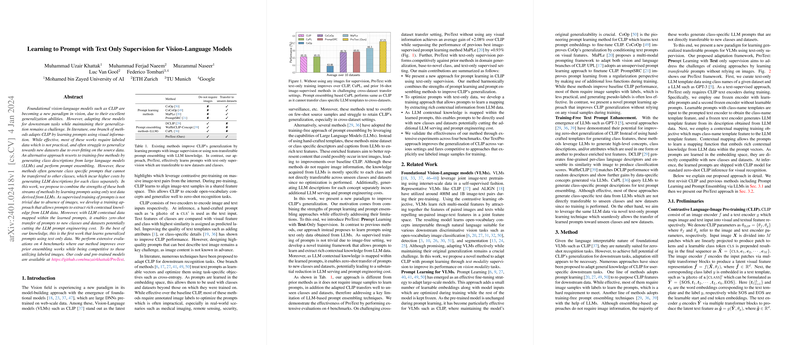Learning to Prompt with Text-Only Supervision for Vision-LLMs: A Professional Overview
The paper "Learning to Prompt with Text-Only Supervision for Vision-LLMs" addresses a significant challenge in adapting vision-LLMs like CLIP for downstream tasks without sacrificing generalization. The authors propose a novel approach that combines the strengths of existing image-supervised prompt learning techniques and training-free prompt ensembling methods using LLMs.
Core Contributions
The paper introduces ProText, a method that leverages text-only supervision to facilitate prompt learning in vision-LLMs. The core contribution of this work is the development of a training framework that enables prompts to learn rich contextual features using only text data obtained from LLMs. This innovative approach bypasses the need for visual sample labels, which are often impractical or expensive to obtain, especially in domains like medical imaging or remote sensing.
Key Methodological Insights
- Text-Only Data Utilization: The authors exploit the capabilities of LLMs to curate detailed class-specific descriptions that serve as the basis for prompt learning. By mapping class names to these descriptions, ProText effectively learns to translate the contextual richness of LLM-generated text into a form usable by vision-LLMs like CLIP.
- Contextual Mapping Loss: The process employs a contextual mapping objective, allowing the learnable prompts to associate standard class-name templates with enriched class-specific textual features from LLMs. This enables the prompts to encapsulate versatile and transferable contextual information, fostering zero-shot learning across new classes and datasets.
- Transferability Across Datasets: ProText’s training does not require visual data, thus preserving VLMs’ ability to adapt to unseen datasets without incurring additional LLM serving or prompt engineering costs. This aspect significantly reduces computational and economic barriers associated with traditional model training approaches.
Methodological Implications and Performance
ProText demonstrates its efficacy through extensive evaluations on four benchmarks, revealing substantial improvements over other prompt ensembling and image-supervised methods. For instance, in the cross-dataset transfer setting, ProText achieves an average accuracy gain of +2.08% over baseline CLIP, outperforming even the best image-supervised methods like MaPLe.
The approach holds promise for enhancing generalization capabilities without the risk of overfitting inherent in image-supervised learning. By tapping into the extensive knowledge embedded within LLMs, ProText equips vision-LLMs with a robust contextual understanding that extends beyond the limitations of training datasets.
Future Prospects
The introduction of text-only supervised prompt learning opens several research avenues. Future work can explore the integration of advanced LLM models and fine-tuning strategies to further enhance the efficiency of ProText. Moreover, expanding the method's applicability to more diverse and complex datasets could provide deeper insights into its scalability and adaptability.
In summary, this paper presents a compelling argument for the use of text-only supervision in enhancing the generalization and transferability of vision-LLMs, emphasizing the importance of leveraging LLMs not just for generating richer features but as a fundamental component in model adaptation strategies. As we move forward, such innovations are poised to redefine how we approach model tuning in the landscape of artificial intelligence.
